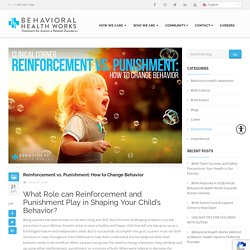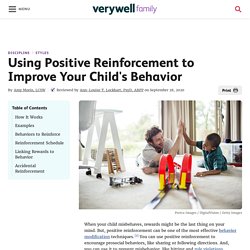

Reinforcement. A consequence applied that will strengthen an organism's future behavior Using a Skinner box to alter the subject rat's behaviour Reinforcement is an important part of operant or instrumental conditioning.

Terminology[edit] In the behavioral sciences, the terms "positive" and "negative" refer when used in their strict technical sense to the nature of the action performed by the conditioner rather than to the responding operant's evaluation of that action and its consequence(s). Parenting on Reinforcement and Punishment. Reinforcement and Punishment at School. Using Reinforcement and Punishment at Home. Positive Parenting Tips. Reinforcement vs. Punishment: Changing Behavior. Being a parent has been known as the best thing ever BUT also the most challenging endeavor you will encounter in your lifetime.

Parents strive to raise a healthy and happy child that will one day grow up as a full-fledged mature and independent adult. But to successfully accomplish this goal, a parent must set forth structure or rules throughout their childhood to help them understand and be realigned when their behavior needs to be modified. When a parent recognizes the need to change a behavior, they will likely end up using either reinforcement, punishment, or a mixture of both. When we’re helping to decrease the frequency of a child’s negative behavior, having the reinforcement or punishment methods in our toolkit can help you modify and implement the desired behavior. Types of Reinforcement. Positive vs Negative Reinforcement. Positive Reinforcement vs Positive Punishment for Kids: Types & Examples. Kids can certainly be a handful.

Every parent knows that although their kids might be the greatest blessing of their lives, at some point or the other, their patience has been tested to the limit. And that is completely okay, because kids learn as they grow and parents grow into the role of great parents only by trial and error, since it is also their first time. Types of Punishment – Which Type is Most Effective on Kids? What is Negative Punishment (Examples and Effectiveness) In this article, we will review negative punishment, its definition, examples, and drawbacks.

American psychologist B.F. Skinner developed the theory of operant conditioning, which stated that a person or animal’s behavior could be increased or decreased by adding or removing appropriate stimuli after the behavior is exhibited. The difference between classical conditioning and operant conditioning is that classical affects unconscious behavior, while operant affects conscious behavior. Within operant, punishment aims to reduce a behavior while reinforcement increase a behavior. Punishment vs reinforcement: Getting the behavior you want from your kids - FamilyToday. Some days, it feels like all we do as parents is discipline our children, but do we understand what discipline really means?

The goal of disciplining children is not to punish them for bad behavior. Rather, discipline is a tool to get the behavior we want. Ultimately, children who receive discipline become disciplined in the way they think, act and speak. What's Positive Reinforcement and How to Use It? How can we ensure that someone repeats certain behavior patterns?

How do we increase their frequency of occurrence? It’s all related to positive reinforcement, a procedure used especially in education and behavioral therapy where people seek to empower certain desired behaviors or attitudes. But what else do we know about positive reinforcement? How is it used? Using Positive Reinforcement to Improve Behavior. When your child misbehaves, rewards might be the last thing on your mind.

But, positive reinforcement can be one of the most effective behavior modification techniques.1 You can use positive reinforcement to encourage prosocial behaviors, like sharing or following directions. And, you can use it to prevent misbehavior, like hitting and rule violations. Positive reinforcement can also be an effective way to encourage and motivate your child to be responsible, do their chores, get along with their siblings, or complete their homework assignments without arguing. How Positive Reinforcement Works Most adults go to work so they can receive a paycheck. Parenting Children with Positive Reinforcement (Examples + Charts) Children don’t come with instructions and discipline is often experienced by parents and children alike as an arena where our will and wits are tested.

Positive reinforcement is only one of many forms of discipline, but from the perspective of positive psychology, it may as well be the most important one as it focuses on amplifying what is already good in our children and in ourselves as their caretakers. Positive reinforcement as a form of positive discipline allows us to tap into our children’s individual strengths, draw attention to their personality traits and interests, and as a result give us an opportunity to connect, communicate effectively, and ultimately empower them to be more of themselves.
Positive Reinforcement and Operant Conditioning. In operant conditioning, positive reinforcement involves the addition of a reinforcing stimulus following a behavior that makes it more likely that the behavior will occur again in the future.

When a favorable outcome, event, or reward occurs after an action, that particular response or behavior will be strengthened. One of the easiest ways to remember positive reinforcement is to think of it as something being added. By thinking of it in these terms, you may find it easier to identify real-world examples of positive reinforcement. Sometimes positive reinforcement occurs quite naturally.
For example, when you hold the door open for someone you might receive praise and a thank you. Psychology Explains How Positive Reinforcement Shapes Child Behavior. <img height="1" width="1" style="display:none;" alt="" src=" /> <img height="1" width="1" style="display:none;" alt="" src=" /> <img height="1" width="1" style="display:none;" alt="" src=" />

Using Positive Reinforcement to Improve Behavior. Negative Reinforcement: What Is It and How Does It Work? What is negative reinforcement? Negative reinforcement is a method that can be used to help teach specific behaviors. With negative reinforcement, something uncomfortable or otherwise unpleasant is taken away in response to a stimulus. Over time, the target behavior should increase with the expectation that the unpleasant thing will be taken away. Examples of Negative Reinforcement. It helps to explore some examples of negative reinforcement, a concept of operant conditioning that people frequently misunderstand. Learn what negative reinforcement is and see how it works in practice. What Negative Reinforcement Is and Is Not Negative reinforcement is about encouragement. The American Psychological Association (APA) reports that it has to do with removing a negative or unpleasant stimulus from a situation in response to someone's action.
Hitting kids: American parenting and physical punishment. When Minnesota Vikings’ running back Adrian Peterson was indicted for hitting his son with a ‘switch’ in September 2014, there was a public furor – with arguments on both sides, but a general sense that Peterson was in the wrong. [i] Quickly, however, the debate over corporal punishment, which was at a fever pitch only two months ago, died down: What explains this turnaround? Perhaps America lost interest because most Americans hit their kids, and most think that that is the way it should be.
More than 70% of Americans agreed in 2012 that, “it is sometimes necessary to discipline a child with a good, hard spanking.” Punishment. What Is 'positive Punishment'? Definition And Real-World Examples. Positive punishment is a popular concept in parenting. We'll explain what it is and how you can implement it with six examples. Parenting isn't always a walk in the park, and determining the best way to address your child's inevitable poor behavior can be a tricky line to walk. Techniques like positive punishment and negative reinforcement (two parenting "buzzwords" that you've probably heard a lot already) are just two of the ways parents and child care providers can try to correct a child's behavioral issues. [RELATED: "Parenting Styles: 4 Negative Reinforcement Examples "]
Reinforcement and Punishment - How to Approach These Concepts in ABA Parent Training — ABA Parent Training: Curriculum, CEUs, Support, & More. As behavior analysts, we understand what the terms “reinforcement” and “punishment” mean in the field of applied behavior analysis. We know that reinforcement refers to the idea that a behavior increases in frequency after the presentation or removal of a stimulus follows that behavior. Reinforcement can be further defined by whether it is positive or negative reinforcement. Positive reinforcement is when a stimulus follows a behavior and that behavior increases in frequency of occurrence in the future. Behaviorism - Positive and negative reinforcement and punishment effectiveness - Psychology & Neuroscience Stack Exchange. Page 2: Learning Key Behavior Principles. Punishment (psychology) The Study of Punishment in Psychology.
12 Examples of Positive Punishment & Negative Reinforcement. CHANGING CHILD'S BEHAVIOUR 1 USING PRAISE,POSITIVE REINFORCEMENT AND APPRECIATION.